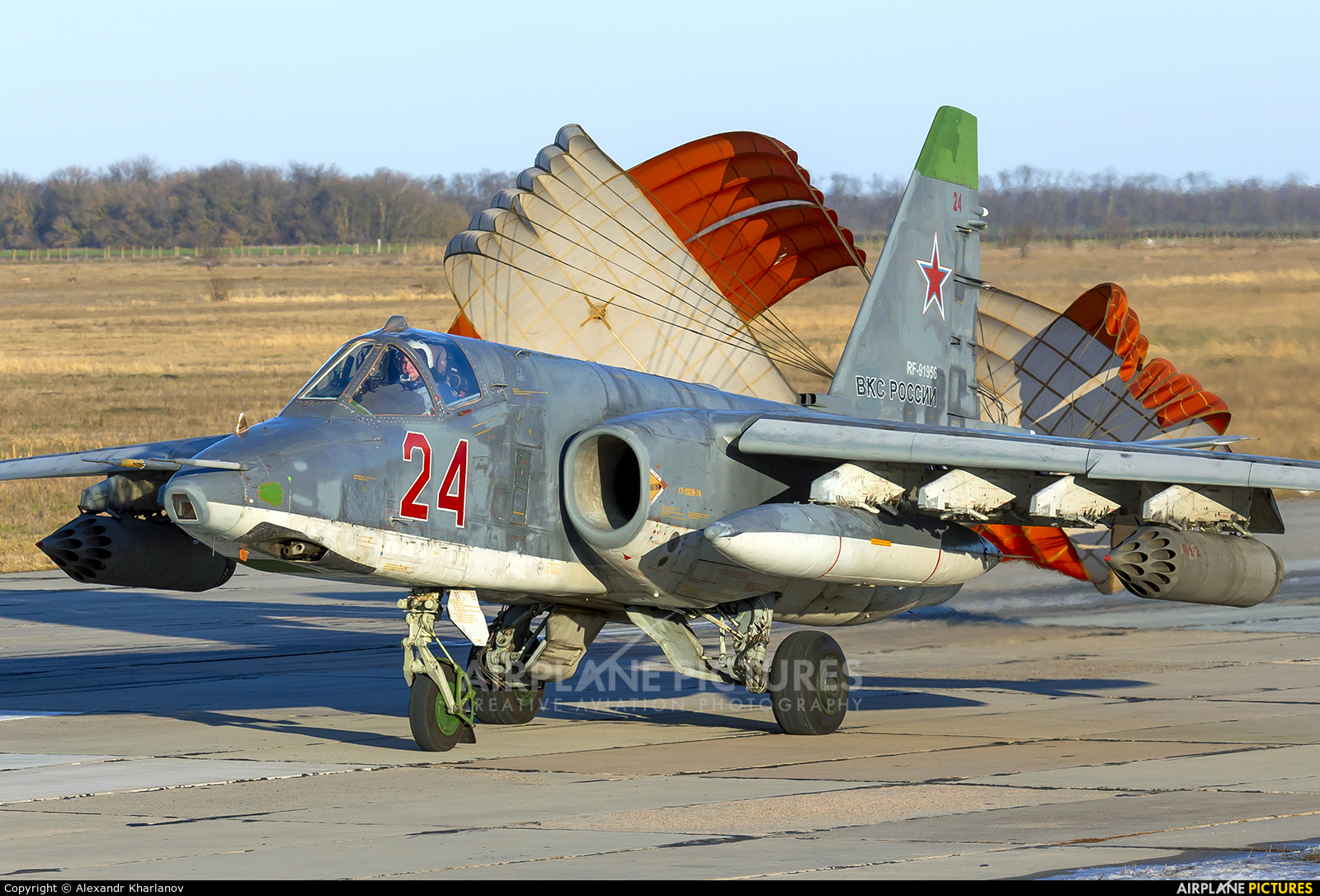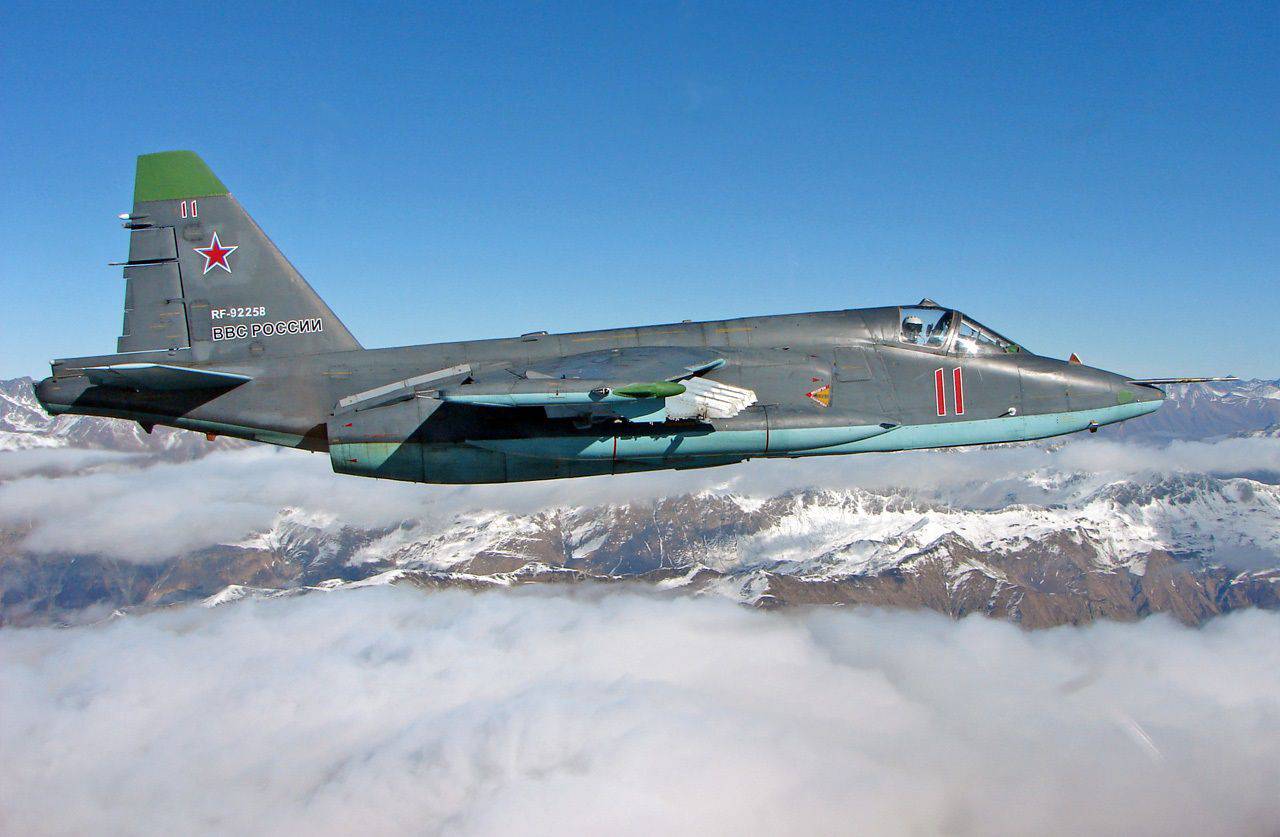Su 25 Sm - The Sukhoi Su-25 Grach (Russian: Грач (rook); NATO reporting name: Frogfoot) is a small, single-seat, twin-engine aircraft manufactured in the Soviet Union by Sukhoi. It was designed to provide close air support for the Soviet Army. The first prototype made its assisted flight on February 22, 1975. After testing, the aircraft entered series production in 1978 in Tbilisi in the Georgian Soviet Socialist Republic.
The first variants are the Su-25UB two-seat trainer, the Su-25BM for towed targets, and the Su-25K for export customers. Several aircraft were upgraded to the Su-25SM standard in 2012. The Su-25T and Su-25TM (also known as Su-39) were redeveloped and not produced in many years. . The Su-25 and Su-34 are the only aircraft produced in 2007.
Su 25 Sm

The Su-25 is in service with Russia, other CIS members, and export customers. Production of Su-25 in 2017 in Russia
Russian Su 25 Jet Shot Down By Paratroopers, Ukrainian Brigade Says
Since tering service more than 41 years ago, the Su-25 has fought in many wars. This type was heavily involved in the Soviet-Afghan War, flying counterinsurgency missions against the Afghan Mujahideen. It was used by the Iraqi Air Force against Iran during the 1980–88 Iran-Iraq War. Most of the Iraqi models were later destroyed or flown to Iran during the 1991 Persian Gulf War. The Georgian Air Force used the Su-25 during the Abkhaz war. from 1992 to 1993. The Macedonian Air Force used the Su-25 against the Albanian rebels in the 2001 Macedonian war, and in 2008, Georgia and Russia used the Su-25 in Russo-Georgian War. African countries, including the Ivory Coast, Chad, and Sudan have used the Su-25 in regional and civil wars. The Su-25 saw action in Russia's intervention in the Syrian Civil War, the 2020 Nagorno-Karabakh War, and the 2022 Russian invasion of Ukraine.
In early 1968, the Soviet Ministry of Defense decided to build shturmovik fighter jets to provide close air support for the Soviet Army. The idea to create ground support aircraft arose after analyzing the experience of ground attack aircraft (shturmovaya) in the 1940s, 1950s and 1960s.
Soviet fighter-bombers in service or development at the time (Su-7, Su-17, MiG-21 and MiG-23) did not meet the requirements for military support.
They lack armor plating to protect pilots and critical equipment from ground fire and missiles, and their flight speeds make it difficult for pilots to maintain visual contact with targets. Considering this problem, Pavel Sukhoi and a team of leading experts of the Sukhoi Design Bureau began the first design work in a short time, with the help of the universities of the Ministry of Aerospace Industry and the Ministry of Defence. .
Su 25 Frogfoot Currently In Russian Service
In March 1969, a competition was announced by the Soviet Air Force wanting to design a close support aircraft. The participants in the competition were the Sukhoi design bureau and the Yakovlev, Ilyushin and Mikoyan design bureau.
Sukhoi finalized the "T-8" design in late 1968, and began production of the first two prototypes (T8-1 and T8-2) in January 1972. The T8- 1, the first aircraft assembled, was completed in May. 9, 1974. Another source in November 1974. However, it did not make its first flight until February 22, 1975, after lengthy test flights by Vladimir Ilyushin. The Su-25 outperformed its main competitor in the Soviet Air Force, the Ilyushin Il-102, and the serial production was announced by the Ministry of Defense.
In the flight test phase of the development of the T8-1 and T8-2 models, the management of the Sukhoi Design Bureau announced that the serial production of the Su-25 should begin at Plant No. 31 in Tbilisi, Soviet Republic of Georgia, which at the time was the main manufacturing base for MiG-21UM "Mongol-B" trainers. After negotiations and the completion of all stages of government testing, the Ministry of Aviation of the Soviet Union authorized the production of the Su-25 in Tbilisi, and serial production began in 1978. .

In the late 1980s and early 1990s, several variants of the Su-25 appeared, including new versions and variants for special missions. The most popular designs are the Su-25UB two-seat trainer, the Su-25BM variable-towing, and the Su-25T for anti-tank missions. In addition, the Su-25KM model was developed by Georgia in cooperation with the Israeli company Elbit Systems in 2001, but so far this variant has not been very successful. It was in 2007
Su 25 Operators
The Russian Air Force, which operates the largest number of Su-25s, plans to upgrade the aging aircraft to the Su-25SM type, but lack of funding has slowed progress. ; as of early 2007 only seven aircraft had been modified.
The Su-25 has a conventional aerodynamic layout with trapezoidal wings attached to the shoulders and tail and rudder. Many metals are used in the construction of the airframe: 60% aluminum, 19% steel, 13.5% titanium, 2% magnesium and 5.5% other materials.
All versions of the Su-25 have metal alloy wings, are easy to clean, have a high profile, and are equipped with high-lift equipment. Two parts of the wing are attached to the central extension box, forming a unit and a wing. Air brakes are placed in the mats at the ends of each wing. Each wing has five hard points for carrying weapons, with additional points attached to the ribs and slots.
The boards are equipped with steel strips and rollers, attached to the brackets on the back. Trapezoidal ailerons are located near the tips of the wings.
Fuselage Keychain Tag Su 25 Grach
The fuselage of the Su-25 has an ellipsoidal section with a semi-monocoque structure, a pressure skin, arranged as a longitudinal load-bearing frame, beams and cables, and transverse load-bearing frame assemblies.
The first versions of the Su-25 were equipped with non-rear-mounted R-95Sh turbojets, in sections on either side of the rear fuselage. The engine, sub-assembly, and surrounding deck are cooled by air provided by cold air inlets above the engine nacelles. The sump collects oil, hydraulic waste and fuel from the engines after a leak or after an idle start. A gene control system allows each gene to function indepdt.
The autocannon is located in a compartment next to the hull and is mounted on a load bearing beam attached to the hull floor and support frame for the forward vehicle. The nose is fitted with a special twin pitot valve and hinges for service access.

The pilot flies the airplane using the left stick and throttle. The pilot sits in a Zvezda K-36 ejection seat (similar to the Sukhoi Su-27) with standard flight equipment. Behind the cockpit is a six-millimetre (0.24 in) thick steel head, which is attached to the rear pillar. It has a bathtub-shaped cover of welded titanium sheets and a wall-mounted switch port. A guide rail for the shooting seat is mounted on the back wall of the pit.
Sukhoi Su 25 “frogfoot”
The cockpit is on the right and the pilot uses the drop-down ladder. Once inside, the pilot sits low in the cockpit, protected by a shower stall, and the cockpit is narrow. Visibility from the cockpit is limited, in exchange for better pilot protection. Rear visibility is poor, and a periscope is mounted above the hull to compress.
A folding ladder built into the left cabin provides access to the cockpit and to the top of the aircraft.
The basic model of the Su-25 has several key avionics systems. It does not have a telescoping guide but includes its own nose-mounted laser pointer, which is thought to provide laser target detection.
The DISS-7 doppler radar is used for navigation; The Su-25 can fly at night, in all weather conditions and equipment.
The Pilot Of The Su 25 Attack Aircraft Landed The Plane At The Home Airfield After Being Hit By A Rocket From A Manpads
The Su-25 is equipped with several radios for air-to-ground and air-to-air communications, including the SO-69 identification-frid-or-enemy (IFF) transponder. The aircraft's self-defense suite includes a variety of gauges, such as a flamethrower and a pod launcher capable of launching up to 250 flares and pods. Bad radar use is protected by the SPO-15 radar warning transmitter.
The new Su-25TM and Su-25SM models have improved airframes and weapons, improving survivability and combat capability.
The first Su-25 unit of the Soviet Air Force was the 80th Attack Aviation Regiment, formed in February 1981 at the Sitalcay air base in the Azerbaijan Soviet Socialist Republic.

On 19 July 1981, the 200th Indepdt Attack Squadron was redeployed to Shindand Air Base in western Afghanistan, becoming the first Su-25 unit to be deployed to the country. Its main task is to deliver air strikes to military bases and structures controlled by Afghan insurgents.
Watch: Russian Su 25sm Fighter Jets Fly Over Donbass Region Ukraine
Another Soviet Su-25 unit is the 368th Attack Aviation Regiment, established on July 12, 1984, in Zhovtneve in Ukraine.
Throughout the Soviet-Afghan War, the Su-25 launched 139 missiles of all types against Mujahidah positions. On average, 360 sorties are flown each year, a higher number than any other combat aircraft in Afghanistan. By the end of the war, about 50 Su-25s had been delivered to Afghan air bases, operating a total of 60,000. Between the first delivery in 1981 and the war in 1989, 21-23 aircraft were lost in combat operations.
Su 25 model kit, su-25 frogfoot, su sm, su 25 model, sm 42byg011 25, icom sm 25, 1 48 su 25, sukhoi su 25 frogfoot, sm-25, 25 sm, su 25, su-25
0 Comments